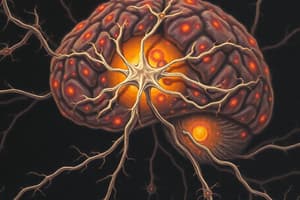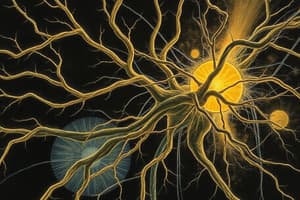Podcast
Questions and Answers
What process involves the presynaptic cell taking back released neurotransmitters?
What process involves the presynaptic cell taking back released neurotransmitters?
- Reuptake (correct)
- Enzymatic degradation
- Autoregulation
- Neuronal inhibition
What initiates an action potential at the axon hillock?
What initiates an action potential at the axon hillock?
- A large summation of excitatory input (correct)
- The release of neurotransmitters alone
- The activation of autoreceptors
- An increase in inhibitory input
How do neurotransmitters primarily affect cells?
How do neurotransmitters primarily affect cells?
- They influence the nearby postsynaptic cells only (correct)
- They directly alter hormone levels
- They provide a global effect on multiple cell types
- They affect all cells in the bloodstream
Which correctly describes the location of autoreceptors?
Which correctly describes the location of autoreceptors?
What is the primary function of the medulla?
What is the primary function of the medulla?
What does the term 'contralateral' refer to?
What does the term 'contralateral' refer to?
Which lobe of the cerebral cortex is primarily involved in processing visual information?
Which lobe of the cerebral cortex is primarily involved in processing visual information?
What role does the cerebellum play in the brain?
What role does the cerebellum play in the brain?
Which structure in the forebrain is essential for memory formation?
Which structure in the forebrain is essential for memory formation?
What is primarily affected by the reticular formation?
What is primarily affected by the reticular formation?
Which brain structure is primarily associated with emotional responses?
Which brain structure is primarily associated with emotional responses?
What is the primary function of the thalamus in the brain?
What is the primary function of the thalamus in the brain?
Which region is responsible for higher cognitive functions and decision making?
Which region is responsible for higher cognitive functions and decision making?
What is the primary function of the hippocampus?
What is the primary function of the hippocampus?
Which structure is referred to as the 'master gland'?
Which structure is referred to as the 'master gland'?
Which of the following is NOT a subdivision of the peripheral nervous system?
Which of the following is NOT a subdivision of the peripheral nervous system?
What is a key function of the thalamus?
What is a key function of the thalamus?
Which part of the autonomic nervous system controls smooth muscles?
Which part of the autonomic nervous system controls smooth muscles?
How are the somas of neurons in the somatic nervous system characterized?
How are the somas of neurons in the somatic nervous system characterized?
Which of the following functions is associated with the hypothalamus?
Which of the following functions is associated with the hypothalamus?
What type of organization characterizes cranial nerves?
What type of organization characterizes cranial nerves?
Which part of the nervous system is responsible for controlling striated muscles?
Which part of the nervous system is responsible for controlling striated muscles?
What structure is primarily associated with regulating arousal and attention?
What structure is primarily associated with regulating arousal and attention?
Which lobe of the brain is primarily responsible for visual processing?
Which lobe of the brain is primarily responsible for visual processing?
How does the left visual field relate to the brain's structure?
How does the left visual field relate to the brain's structure?
Which division of the nervous system includes cranial and spinal nerves?
Which division of the nervous system includes cranial and spinal nerves?
What is a major function of the sympathetic nervous system?
What is a major function of the sympathetic nervous system?
Which of the following structures is part of the brainstem?
Which of the following structures is part of the brainstem?
What is the primary role of the cerebral cortex?
What is the primary role of the cerebral cortex?
What is the primary function of sensory neurons?
What is the primary function of sensory neurons?
What are the terminal buttons on a neuron best described as?
What are the terminal buttons on a neuron best described as?
Which type of neuron is responsible for connecting small circuits to other brain regions?
Which type of neuron is responsible for connecting small circuits to other brain regions?
What is the process called when a presynaptic neuron releases neurotransmitters?
What is the process called when a presynaptic neuron releases neurotransmitters?
Which part of the neuron is primarily responsible for receiving signals from other neurons?
Which part of the neuron is primarily responsible for receiving signals from other neurons?
What initiates the firing of an action potential in a neuron?
What initiates the firing of an action potential in a neuron?
What role do glial cells play in the nervous system?
What role do glial cells play in the nervous system?
Which of the following correctly describes interneurons?
Which of the following correctly describes interneurons?
Flashcards are hidden until you start studying
Study Notes
The Nervous System: Cells and Functions
- The nervous system is comprised of neurons and glial cells.
- Neurons are specialized cells that transmit and modify information.
- Glial cells support the functions of neurons.
- There are approximately 100 billion neurons in the human nervous system.
- Sensory neurons collect information from the environment (light, chemicals, sounds).
- Motor neurons control muscle contraction.
- Interneurons are in the central nervous system and are neither sensory nor motor neurons.
- Local interneurons analyze small pieces of information by forming local circuits.
- Relay interneurons connect local circuits to other brain regions.
Neuron Structure and Communication
- Soma (cell body): Contains the nucleus and carries out housekeeping activities.
- Dendrites: Branch-like structures that receive signals from other neurons.
- Axon: A single, long branch that sends signals to other neurons or muscles.
- Terminal Buttons: The tips of axons that contain vesicles filled with neurotransmitters.
- Neurotransmitters: Chemicals that have inhibitory or excitatory effects when released.
- Synaptic Gap: The space between the terminal button of one neuron and the dendrite of another.
- Presynaptic cells release neurotransmitters.
- Postsynaptic cells receive information by detecting the presence of neurotransmitters.
- When a presynaptic neuron is sufficiently excited, it fires an action potential.
- The summation of excitatory input must be large enough to initiate an action potential at the axon hillock.
Neurotransmitter Removal and Autoreceptors
- Neurotransmitters cannot remain in the synaptic gap indefinitely.
- Reuptake: Presynaptic cells reabsorb released neurotransmitters.
- Enzymatic Deactivation: Enzymes break down neurotransmitters in the synaptic gap.
- Autoreceptors are located on the terminal button of the presynaptic cell.
- Autoreceptors detect the amount of neurotransmitter released and regulate further release.
Neurotransmitters vs. Hormones
- Neurotransmitters are released by neurons into the synaptic gap, affecting only the postsynaptic cell.
- Hormones are released by endocrine glands into the bloodstream.
- Hormones can reach any cell in the body and have global effects on many cell types.
Anatomical Directions in the Nervous System
- Neuroaxis: An imaginary line from the forebrain to the tip of the spinal cord.
- Anterior (rostral): Towards the front.
- Posterior (caudal): Towards the back.
- Dorsal (superior): Towards the top.
- Ventral (inferior): Towards the bottom.
- Medial: Towards the center.
- Lateral: Towards the periphery.
- Ipsilateral: On the same side.
- Contralateral: On the opposite side.
Divisions of the Nervous System
- The Central Nervous System (CNS) consists of the brain and spinal cord.
- The Peripheral Nervous System (PNS) connects the CNS to the rest of the body, made up of cranial, spinal nerves, and ganglia.
Peripheral Nervous System (PNS)
- The PNS has three major divisions:
- Somatic Nervous System: Controls voluntary movement of skeletal muscles.
- Autonomic Nervous System: Controls involuntary functions like heart rate, digestion, and breathing.
- Enteric Nervous System: Controls digestive functions.
Autonomic Nervous System
- Sympathetic Nervous System: "Fight-or-flight" response to stress.
- Parasympathetic Nervous System: "Rest-and-digest" response, promotes relaxation.
The Brain: Major Structures and Functions
-
Forebrain: The largest and most complex part of the brain.
- Cerebral Cortex: The outer layer of the forebrain, responsible for higher cognitive functions.
- Frontal Lobe: Planning, decision-making, language, movement.
- Parietal Lobe: Touch, spatial awareness, attention.
- Occipital Lobe: Vision.
- Temporal Lobe: Auditory processing, memory, language.
- Subcortical Structures:
- Thalamus: Relays sensory information to the cortex.
- Hypothalamus: Controls basic drives and homeostasis (hunger, thirst, temperature).
- Amygdala: Processes emotions, especially fear.
- Limbic System: Involved in emotion, motivation, memory.
- Basal Ganglia: Controls movement and coordination.
- Cerebral Cortex: The outer layer of the forebrain, responsible for higher cognitive functions.
-
Brainstem: Connects the brain to the spinal cord.
- Midbrain: Integrates sensory and motor information, controls eye movement.
- Hindbrain:
- Medulla: Regulates breathing, heart rate, and blood pressure.
- Pons: Involved in sleep, dreaming, arousal.
- Cerebellum: Coordinates movement, balance, and motor learning.
Additional Forebrain Structures
- Cingulate Gyrus: Involved in attention, emotion, and decision-making.
- Hippocampus: Critical for learning and memory.
- Amygdala: Processes emotions, especially fear.
Hypothalamus and Hormones
- Hypothalamus: Small but vital for:
- Autonomic Nervous System control.
- Endocrine System control.
- Pituitary Gland: "Master gland" that secretes hormones that regulate other glands.
- Survival Behavior: Regulates the "4 F's": fighting, feeding, fleeing, mating.
Peripheral Nervous System: Cranial and Spinal Nerves
- Cranial Nerves: Twelve pairs of nerves originating in the brainstem, serving the head and face.
- Spinal Nerves: Originate from the spinal cord and serve the rest of the body.
Somatic Nervous System
- Somatosensory: Carries sensory information from the body to the CNS.
- Motor: Carries commands from the CNS to skeletal muscles to control movement.
Autonomic Nervous System: Key Features
- Controls smooth muscles, glands, and internal organs.
- Functions automatically without conscious control.
Enteric Nervous System
- A network of neurons within the gut.
- Controls digestive processes.
Studying That Suits You
Use AI to generate personalized quizzes and flashcards to suit your learning preferences.





